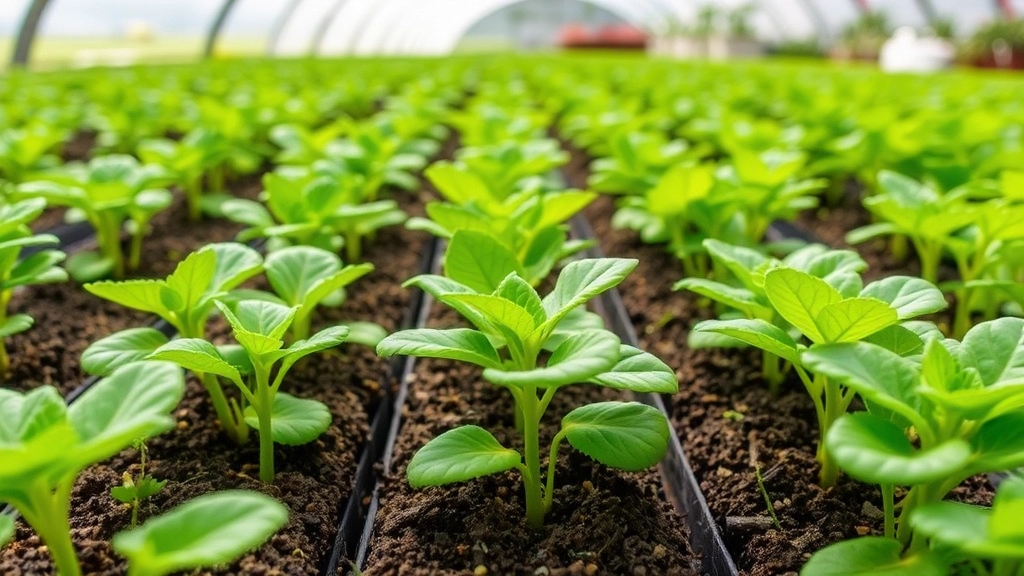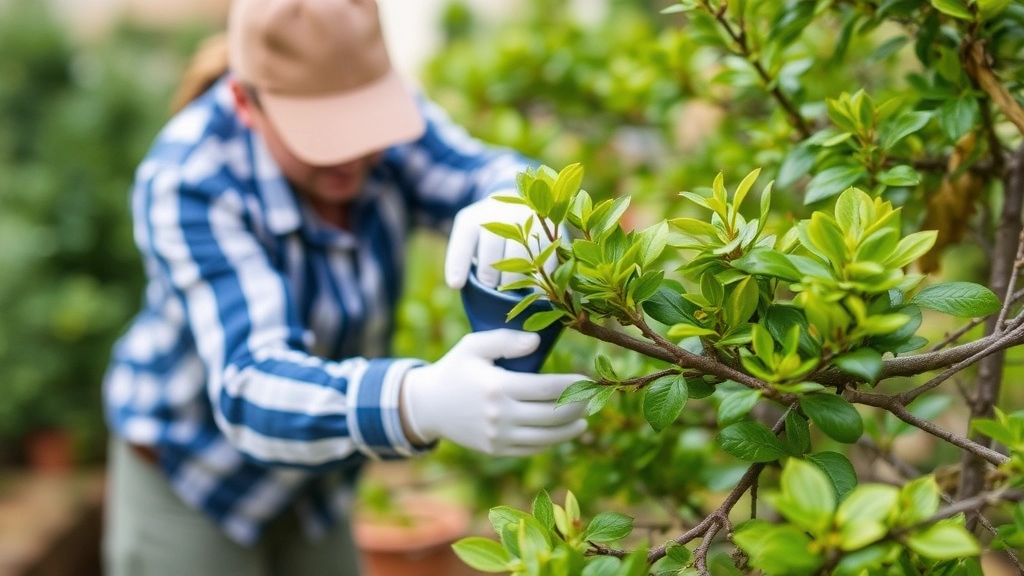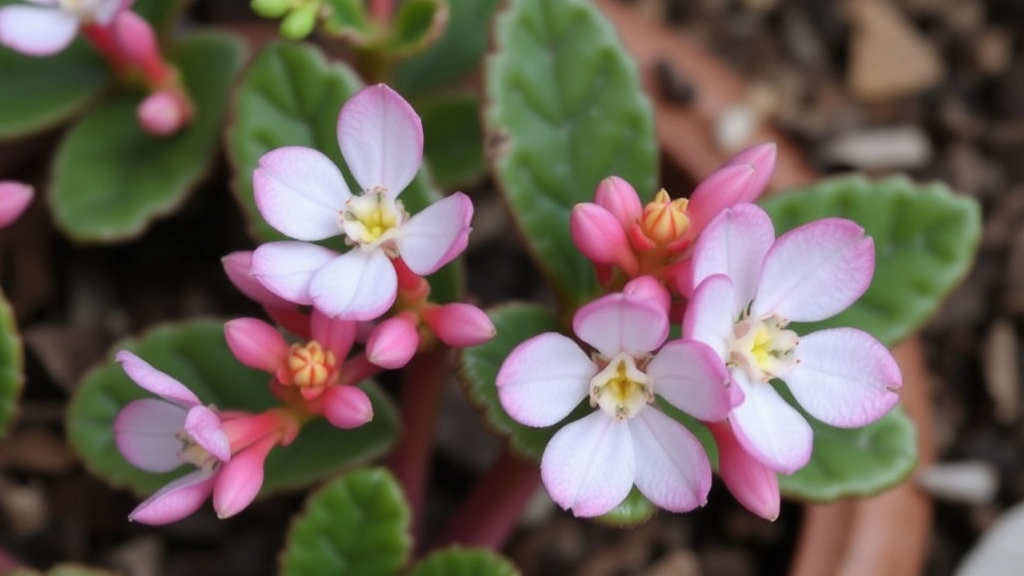Welcome to Kalanchoe beharensis
Welcome to the fascinating world of Kalanchoe beharensis, a truly extraordinary succulent that’s bound to captivate plant enthusiasts and novices alike. In this comprehensive guide, we’ll explore the unique characteristics, ideal growing conditions, and essential care tips for this remarkable plant, affectionately known as the Felt Bush or Elephant’s Ear Kalanchoe.
Unique Characteristics
From its massive, velvety leaves that can reach up to 20 inches long to its impressive height potential of 20 feet in the wild, Kalanchoe beharensis is a showstopper in any setting. We’ll delve into its sun-loving nature, temperature preferences, and specific soil requirements, ensuring you have all the knowledge needed to help this stunning succulent thrive in your home or garden.
Characteristics of Kalanchoe Beharensis
Ever stumbled upon a plant that looks like it’s from another planet? That’s Kalanchoe beharensis for you.
This bad boy’s got some serious swagger in the succulent world.
Let’s break it down:
- Massive leaves: We’re talking up to 20 inches long. No joke.
- Fuzzy texture: Like velvet, but tougher.
- Unique color: Silver-green that’ll make your other plants jealous.
- Thick stems: Built like a tree, but it’s actually a succulent.
- Slow growth: Patience is key, folks.
Here’s the kicker – it can reach up to 20 feet tall in the wild. In your living room? Probably not.
But it’ll still be the coolest plant at your next dinner party.
It’s got these little bumps on the leaves that look like dinosaur skin. Jurassic Park, anyone?
And when it flowers? Orange clusters that’ll make you do a double-take.
Bottom line: Kalanchoe beharensis is a showstopper. It’s weird, it’s wonderful, and it’s definitely not your average houseplant.
Ideal Growing Conditions

Let’s dive into the sweet spot for growing Kalanchoe beharensis, shall we? These funky succulents aren’t your average houseplants, and they’ve got some specific needs to really thrive.
Sun-Loving Beasts
First things first, these guys are sun worshippers. They’re like that friend who’s always chasing the perfect tan. Full sun is their jam, but they can handle partial shade if they must. Just remember, the more light they get, the happier they’ll be.
Temperature Tolerance
Now, here’s where it gets interesting. Kalanchoe beharensis is tougher than it looks:
- They can handle heat like a champ (up to 30°C/86°F)
- Cold? Not so much. Keep ’em above 10°C/50°F
- Frost? Forget about it. These babies will turn to mush
Soil Matters
Think fast-draining and slightly acidic. Here’s a quick mix you can whip up:
- 2 parts potting soil
- 1 part perlite or coarse sand
- 1 part coconut coir
This combo gives them the drainage they crave while holding just enough moisture.
Humidity? Meh.
Unlike some fussy tropicals, Kalanchoe beharensis doesn’t need you misting it every five minutes. Average room humidity is fine. In fact, too much moisture in the air can lead to rot. Nobody wants that.
Space to Grow
These aren’t your tiny desk succulents. Given the right conditions, Kalanchoe beharensis can become a beast:
- Indoor: Choose a spot with plenty of headroom
- Outdoor: Give it space to spread its wings (or leaves, in this case)
Remember, the key to nailing the ideal growing conditions for Kalanchoe beharensis is mimicking its natural habitat. Think hot, dry, and bright. Get these basics right, and you’ll have a thriving, eye-catching succulent that’ll make your plant-loving friends green with envy. If you’re interested in other Kalanchoe varieties, check out the succulent Kalanchoe tomentosa for a fuzzy alternative. And for those looking to expand their Kalanchoe collection, learning how to propagate Kalanchoe tomentosa can be a fun and rewarding experience.
Watering and Feeding Requirements
Alright, let’s dive into the watering and feeding requirements for Kalanchoe beharensis.
Here’s the deal with these succulents:
Water: Less is more
- These guys are drought-tolerant champs.
- Overwatering? That’s their kryptonite.
- Let the soil dry out completely between waterings.
- In summer, water every 2-3 weeks.
- Winter? Cut back even more.
Feeding: Keep it light
- These aren’t hungry plants.
- Feed sparingly during the growing season.
- Use a balanced, water-soluble fertilizer.
- Dilute it to half strength.
- Once a month is plenty.
- Skip feeding in winter.
Pro tip: Watch the leaves
- Wrinkled leaves? Time for a drink.
- Yellow leaves? Ease up on the water.
Remember, Kalanchoe beharensis is tough.
It’s better to underwater than overwater.
Got questions about your plant’s needs?
Just ask! Every plant’s a bit different.
The key is finding the sweet spot for your Kalanchoe beharensis.
Propagation Techniques

Alright, let’s dive into how we can make more of these funky Kalanchoe beharensis plants. Trust me, it’s easier than you might think!
Leaf Cuttings: The Lazy Way
Here’s a trick I love: just snip off a healthy leaf, let it dry for a day or two, then pop it on some well-draining soil. Boom! In a few weeks, you’ll see tiny roots and maybe even a baby plant. It’s like magic, but it’s just plant science doing its thing.
Stem Cuttings: For the Impatient Gardener
If you’re in a hurry (like me most days), go for stem cuttings:
- Cut a 4-6 inch piece from a healthy stem
- Remove lower leaves
- Let it callous over for a day
- Stick it in some cactus mix
- Keep it warm and slightly moist
Before you know it, you’ll have roots and new growth. It’s like cloning, but way cooler and totally legal.
Division: The Surgical Approach
Got a big, bushy Kalanchoe? Time for some plant surgery:
- Carefully dig up the plant
- Gently separate the roots
- Replant each section
It’s like giving your plant a haircut and getting new plants as a bonus. Win-win!
Seeds: The Patient Person’s Game
Honestly, I rarely bother with seeds. They’re fiddly and take forever. But if you’re into that sort of thing, go for it. Just remember, Kalanchoe blossfeldiana cuttings are usually easier to work with than seeds. They’re tiny, so you’ll need a steady hand and a lot of patience.
Pro Tip: Whichever method you choose, always use clean tools. We don’t want any plant diseases crashing our propagation party!
Remember, propagating Kalanchoe beharensis is all about patience and a bit of plant love. Give it a go, and before you know it, you’ll have enough plants to start your own jungle. Who knows? You might even become the neighbourhood’s Kalanchoe blossfeldiana for sale expert!
Common Pests and Diseases
Let’s chat about the not-so-fun part of growing Kalanchoe beharensis: pests and diseases.
Trust me, I’ve been there, and it’s no picnic.
But don’t worry, I’ve got your back.
Here’s the lowdown on what to watch out for:
Pests:
- Mealybugs: These little cotton-ball lookalikes love to party on your plant.
- Spider mites: Tiny troublemakers that can cause big problems.
- Aphids: Green, sap-sucking nuisances that multiply like crazy.
Diseases:
- Root rot: Too much water? Your plant’s roots might throw in the towel.
- Powdery mildew: Looks like someone dusted your plant with flour. Not cool.
- Leaf spot: Brown spots on leaves? Could be fungal trouble.
Now, here’s the million-dollar question: How do we deal with these pests and diseases?
Simple. Prevention is key.
Keep your Kalanchoe beharensis happy and healthy, and it’ll be less likely to attract unwanted guests.
But if trouble does show up, don’t panic.
For pests, a good spray down with neem oil usually does the trick.
For diseases, improving air circulation and adjusting your watering habits can work wonders.
Remember, your Kalanchoe beharensis is tough. With a little TLC, it’ll bounce back from most issues.
Just keep an eye out, act fast, and you’ll be golden.
Pruning and Maintenance Tips

Let’s chat about keeping your Kalanchoe beharensis looking sharp, shall we? I’ve learned a thing or two about pruning these bad boys, and I’m gonna spill the tea.
First things first: why bother pruning?
Well, here’s the deal:
- It keeps your plant from getting too leggy
- Encourages bushier growth
- Helps manage its size (these suckers can get big!)
- Removes any dead or damaged bits
Now, when should you grab those pruning shears?
Timing is key, folks. I usually go for it in spring or early summer. That’s when your Kalanchoe’s in its growing mood, ready to bounce back from a trim.
Here’s my go-to pruning routine:
- Sterilise your tools (nobody wants plant diseases, right?)
- Cut just above a leaf node at a 45-degree angle
- Remove any dead, yellowing, or damaged leaves
- If it’s getting too tall, don’t be shy – you can lop off up to a third of the plant
Pro tip: Save those cuttings! They’re gold for propagating Kalanchoe blossfeldiana.
Maintenance beyond pruning? It’s pretty chill:
- Dust the leaves now and then (helps with photosynthesis)
- Remove any fallen leaves to keep pests at bay
- Check for signs of trouble regularly (spots, discolouration, you know the drill)
Remember, Kalanchoe beharensis is a tough cookie. It doesn’t need constant fussing. But a little TLC goes a long way in keeping it happy and healthy. If you’re looking for more specific care tips, you might want to check out how to care for Kalanchoe tomentosa, which shares some similarities with beharensis.
Got any pruning horror stories or success tales? Drop ’em in the comments – I’m all ears!
Benefits of Growing Kalanchoe Beharensis
Let’s chat about why Kalanchoe Beharensis is a game-changer for your space.
Ever wondered how to jazz up your home without the hassle? This plant’s got you covered.
First off, it’s a stunner. Those big, fuzzy leaves? They’re like nature’s artwork.
But it’s not just a pretty face. This bad boy is tough as nails.
Forget about high-maintenance plants. Kalanchoe Beharensis is like that chill friend who’s always up for a good time.
Here’s the real kicker:
- It purifies the air (bye-bye, nasty toxins!)
- Thrives in low light (perfect for those dark corners)
- Drought-resistant (forget to water? No worries)
- Low-allergy (sneeze-free zone, anyone?)
But wait, there’s more!
This plant’s a natural stress-buster. Just looking at it can calm your nerves.
And let’s talk about that unique texture. It’s like touching a cloud, but better.
Got kids or pets? No stress. Kalanchoe Beharensis is non-toxic.
Here’s a pro tip: Use it as a focal point in your room. Trust me, it’ll steal the show.
Bottom line? Kalanchoe Beharensis is more than just a plant. It’s a lifestyle upgrade.
So, ready to bring this green superstar home? Your space (and your sanity) will thank you.
Popular Varieties and Cultivars

Alright, let’s dive into the world of Kalanchoe beharensis varieties. Trust me, there’s more to this plant than meets the eye!
Kalanchoe beharensis, or the Felt Bush, is already a stunner on its own. But plant breeders have been busy, and now we’ve got some seriously cool cultivars to choose from. Let me break it down for you:
1. ‘Fang’
This bad boy is all about the drama. It’s got these wicked tooth-like projections along the leaf edges. Imagine a plant with vampire teeth – that’s ‘Fang’ for you!
2. ‘Silver Elephant Ears’
Just like it sounds, this variety has massive, silvery leaves that look like elephant ears. It’s a real showstopper in any garden or indoor space.
3. ‘Orange’
Don’t let the name fool you – it’s not actually orange. This variety has leaves that start off bronze and mature to a silvery-green. It’s like watching a colour-changing magic trick in slow motion.
4. ‘Maltese Cross’
This one’s got leaves that grow in a cross shape, hence the name. It’s perfect if you’re after something a bit different.
5. ‘Beharii’
The OG Kalanchoe beharensis. It’s got those classic velvety, grey-green leaves that made us fall in love with this plant in the first place.
Here’s the thing about these varieties – they’re all tough as nails. Whether you’re a plant newbie or a seasoned pro, these guys are pretty forgiving. They’ll survive a bit of neglect (not that I’m encouraging that, mind you).
But here’s a pro tip: if you’re after the most striking look, go for ‘Fang’ or ‘Silver Elephant Ears’. These varieties really show off what Kalanchoe beharensis can do.
Remember, whichever variety you choose, they all need similar care. Bright light, well-draining soil, and not too much water. Get those basics right, and you’ll have a happy Kalanchoe on your hands.
So, which Kalanchoe beharensis variety are you going to try? Trust me, once you start with one, you might just find yourself wanting to collect them all! If you’re interested in other Kalanchoe species, you might want to check out the Kalanchoe tomentosa propagation guide or learn about the Kalanchoe pinnata miracle leaf.
Troubleshooting Common Issues
Let’s chat about the hiccups you might face with your Kalanchoe beharensis.
These fellas can be a bit finicky, but don’t sweat it. We’ve all been there.
Here’s the lowdown on common issues and how to sort ’em out:
Yellowing leaves:
- Overwatering’s often the culprit
- Ease up on the H2O and check your drainage
- Might be nutrient deficiency – give it a feed
Leaf drop:
- Could be too much sun or not enough
- Try moving it to a spot with bright, indirect light
- Cold drafts can cause this too – keep it cosy
Brown spots:
- Sunburn’s a common cause
- Gradually introduce it to more light
- Fungal issues? Trim affected leaves and improve air circulation
Leggy growth:
- Not enough light, mate
- Find a brighter spot
- Prune it back to encourage bushier growth
Pests:
- Keep an eye out for mealybugs and spider mites
- Wipe leaves with soapy water or neem oil
- Isolate affected plants to prevent spread
Root rot:
- Overwatering strikes again
- Let the soil dry out between waterings
- Repot in fresh, well-draining soil if needed
Remember, Kalanchoe beharensis is tough as nails. With a bit of TLC, you’ll sort these issues in no time.
Got any other Kalanchoe beharensis troubles? Hit me up, and we’ll figure it out together.
Companion Plants for Kalanchoe Beharensis
Let’s chat about pairing up your Kalanchoe beharensis with some plant pals. It’s like matchmaking, but for your green buddies.
First off, Kalanchoe beharensis loves hanging out with other succulents and drought-tolerant plants. Why? They’re all on the same wavelength when it comes to water needs. No drama, no fuss.
Here are some solid companions that’ll vibe well with your Kalanchoe:
- Echeveria: These rosette-shaped beauties come in a rainbow of colours. They’re low-maintenance, just like our Kalanchoe mate.
- Sedum: Tough as nails and pretty to boot. They’ll happily share space without stealing the spotlight.
- Aloe vera: Not just for sunburns! Aloe’s spiky leaves contrast nicely with Kalanchoe’s fuzzy ones.
- Agave: For a bit of architectural interest. Just watch out for those sharp tips!
- Crassula: The Jade plant’s a classic. It’ll grow alongside Kalanchoe without any beef.
But here’s the thing – it’s not just about looks. These plants all dig similar conditions:
- Bright light
- Well-draining soil
- Infrequent watering
So, you’re not just creating a pretty picture, you’re making life easier for yourself too. Win-win, right?
Now, let’s talk about mixing it up a bit. Fancy adding some texture? Try pairing Kalanchoe beharensis with:
- Senecio rowleyanus (String of Pearls): Its trailing stems will soften the edges of your display.
- Burro’s Tail: Another cascading beauty that’ll add some movement to your arrangement.
Remember, though, Kalanchoe beharensis can get big. So give it some room to stretch out. You don’t want it bullying its new friends!
And here’s a pro tip: group your plants in odd numbers. It’s more pleasing to the eye. Trust me on this one.
So there you have it. Companion planting with Kalanchoe beharensis isn’t rocket science. It’s about finding plants that look good together and share similar needs. Easy peasy, right? Now go forth and create your own succulent squad!
FAQs about Kalanchoe Beharensis
1. How big does Kalanchoe beharensis get?
In the wild, Kalanchoe beharensis can reach up to 20 feet tall. However, as a houseplant, it typically grows to about 3-6 feet tall. The size can be controlled through regular pruning.
2. Is Kalanchoe beharensis toxic to pets?
Unlike some other Kalanchoe species, Kalanchoe beharensis is generally considered non-toxic to pets. However, it’s always best to keep plants out of reach of curious pets to prevent any digestive upset.
3. How often should I water my Kalanchoe beharensis?
Kalanchoe beharensis is drought-tolerant and prefers to dry out between waterings. In summer, water every 2-3 weeks, and reduce watering frequency in winter. Always check the soil moisture before watering.
4. Can Kalanchoe beharensis be grown outdoors?
Yes, Kalanchoe beharensis can be grown outdoors in USDA zones 9-11. It thrives in full sun to partial shade and needs protection from frost. In colder climates, it’s best grown as a container plant that can be moved indoors during winter.
5. How do I propagate Kalanchoe beharensis?
Kalanchoe beharensis can be propagated through leaf cuttings, stem cuttings, or division. Stem cuttings are the most common method. Allow the cutting to callous over for a day or two before planting in well-draining soil.
6. Why are my Kalanchoe beharensis leaves turning yellow?
Yellowing leaves are often a sign of overwatering. Ensure your plant has well-draining soil and only water when the soil is completely dry. It could also indicate a nutrient deficiency, so consider fertilizing during the growing season.
7. Does Kalanchoe beharensis flower?
Yes, Kalanchoe beharensis can produce flowers, although it’s not common in indoor plants. When it does flower, it produces clusters of small, orange flowers.
8. How do I prevent my Kalanchoe beharensis from getting leggy?
To prevent legginess, ensure your plant gets enough light. If it’s not getting sufficient light, move it to a brighter location. Regular pruning can also encourage bushier growth.
9. What type of soil is best for Kalanchoe beharensis?
Kalanchoe beharensis prefers well-draining, slightly acidic soil. A mix of 2 parts potting soil, 1 part perlite or coarse sand, and 1 part coconut coir works well.
10. Can I grow Kalanchoe beharensis from seeds?
While it’s possible to grow Kalanchoe beharensis from seeds, it’s not the most common or easiest method. Propagation through cuttings is generally faster and more reliable.
References
-
Missouri Botanical Garden – Kalanchoe beharensis Plant Finder: Kalanchoe beharensis

